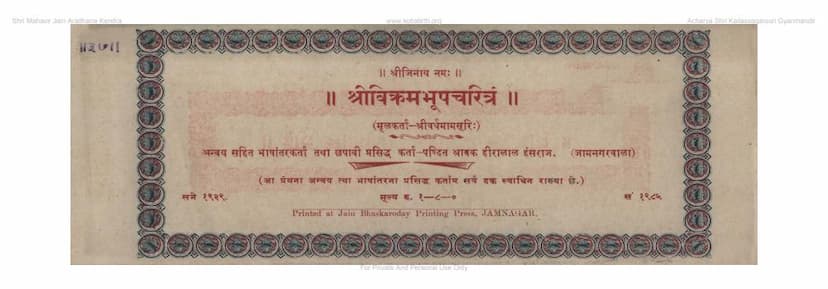Vikrambhup Charitram
Added to library: September 2, 2025

Summary
Here's a comprehensive summary of the Jain text "Vikrambhup Charitram" by Vardhamansuri, based on the provided pages:
The text, "Vikrambhup Charitram" (The Biography of King Vikram), authored by Shri Vardhamansuri, is presented with Sanskrit verses, their Gujarati translations, and explanations. The publication details indicate it was printed in 1929 by Shravak Hiralal Hansraj of Jamnagar.
Core Theme: The Power of Samyakva (Right Faith)
The central message of this biography is the profound impact of Samyakva (Samyaktva), which is defined as unwavering faith in the omniscient one (Sarvajna), the true guru (Sadguru), and the righteous path (Dharma). The text asserts that possessing Samyakva leads to divine favor, prosperity, and the ability to overcome all adversities.
The Story of King Vikram:
The narrative unfolds with the birth of Vikram, the son of King Haritilak and Queen Gauri. He is born to a childless couple, and his auspicious birth is marked by his father conquering his enemies. This is why he is named "Vikram," signifying prowess.
Vikram's Early Life and Affliction:
Vikram grows up to be a virtuous, obedient, and knowledgeable prince, proficient in all arts and sciences. He marries thirty-two princess. However, in the prime of his youth, he is struck by a severe and debilitating illness. The text describes his suffering in vivid detail, listing numerous ailments that afflict him, making all treatments and remedies ineffective. He endures immense pain, leading him to make a vow to offer a hundred buffaloes to the yaksha Dhananjaya for relief.
The Arrival of Vimalakirti and Vikram's Insight:
During this time of suffering, a great Jain monk, Acharya Vimalakirti, arrives at the royal pleasure garden. King Haritilak, along with the afflicted Vikram, goes to pay respects to the monk. Observing the futility of the remedies applied to Vikram, Vikram himself realizes that his diseases are growing with every treatment, much like greed grows with gains. He compares his situation to a mountain being attacked by elephant tusks, where the remedies (like mantras, medicines, and rituals) are ineffective against the powerful diseases.
Vikram's Turning Point and Renunciation of External Reliance:
Vikram understands that his suffering is due to his past negative actions (karma). He resolves to seek true spiritual guidance rather than relying on external means. He requests his father to allow him to visit the monk.
The Monk's Discourse and Vikram's Past Life:
When Vikram meets Acharya Vimalakirti, he expresses his plight to the monk. The monk, with his divine knowledge, reveals the reason for Vikram's suffering by recounting a past life story. In a previous life, Vikram was born as King Padma in the city of Ratnasthala in Aparavideha. This King Padma was cruel and an enemy of Dharma and knowledge. He brutally killed a virtuous monk named Suyasha by stabbing him with a dagger. As a consequence of this heinous act, King Padma was reborn in various hellish realms and animal forms, experiencing immense suffering across countless lifetimes. The monk explains that Vikram's current illness is a result of the residual effects of those past sins.
The Monk's Intervention and the Yaksha's Defeat:
The monk, through his spiritual power and divine knowledge, explains that Vikram's suffering is a manifestation of his past karma. He then dispels the darkness of ignorance (avidya) within Vikram. Subsequently, the yaksha Dhananjaya appears, demanding his promised sacrifice. Vikram, now enlightened by the monk's teachings, refuses to offer him any living beings, stating that his body has been purified by the monk's teachings (Dharma as medicine). He argues that no wise person would abandon the medicine of Dharma to embrace the sin of killing. The yaksha, enraged by Vikram's refusal and the monk's presence, attacks Vikram. However, the monk, imbued with divine energy, incinerates the yaksha.
Vikram's Acceptance of Jain Dharma:
Inspired by the monk's power and the understanding of his past actions, Vikram embraces the path of a shravaka (lay follower) by accepting the twelve vows. He develops immense devotion and understanding of Dharma.
The King's Transformation and Kingdom's Prosperity:
King Haritilak is also transformed by the teachings and becomes a virtuous ruler. He relinquishes his kingdom to Vikram and passes away. Vikram, now King Vikram, rules his kingdom with justice and righteousness. His reign is characterized by peace, prosperity, and the happiness of his subjects, who emulate his virtues.
The Story of King Yama and the War:
The text then narrates an incident where King Yama of Kalinga attacks Vikram's kingdom. Vikram, with his divine power and strategic prowess, defeats King Yama. The yaksha Dhananjaya reappears, humbled by Vikram's spiritual strength, and offers his allegiance.
The Monk's Departure and Vikram's Asceticism:
The monk, Acharya Vimalakirti, after bestowing his blessings and further teachings, departs. Vikram, now deeply devoted to the path of liberation, renounces his kingdom to his son Chandrasena and himself embarks on the path of asceticism, performing rigorous penance.
Vikram's Attainment of Moksha:
Through his devoted practice, adherence to righteous conduct, and the grace of the monk, Vikram eventually attains omniscience (Kevala Jnana) and liberates himself from the cycle of birth and death (Moksha).
Concluding Message:
The text concludes by emphasizing that by following Samyakva as demonstrated by King Vikram, one can achieve liberation from worldly suffering and attain ultimate peace and happiness. The biography serves as an illustration of the power of true faith, right conduct, and spiritual wisdom in overcoming karmic retribution and achieving spiritual emancipation.